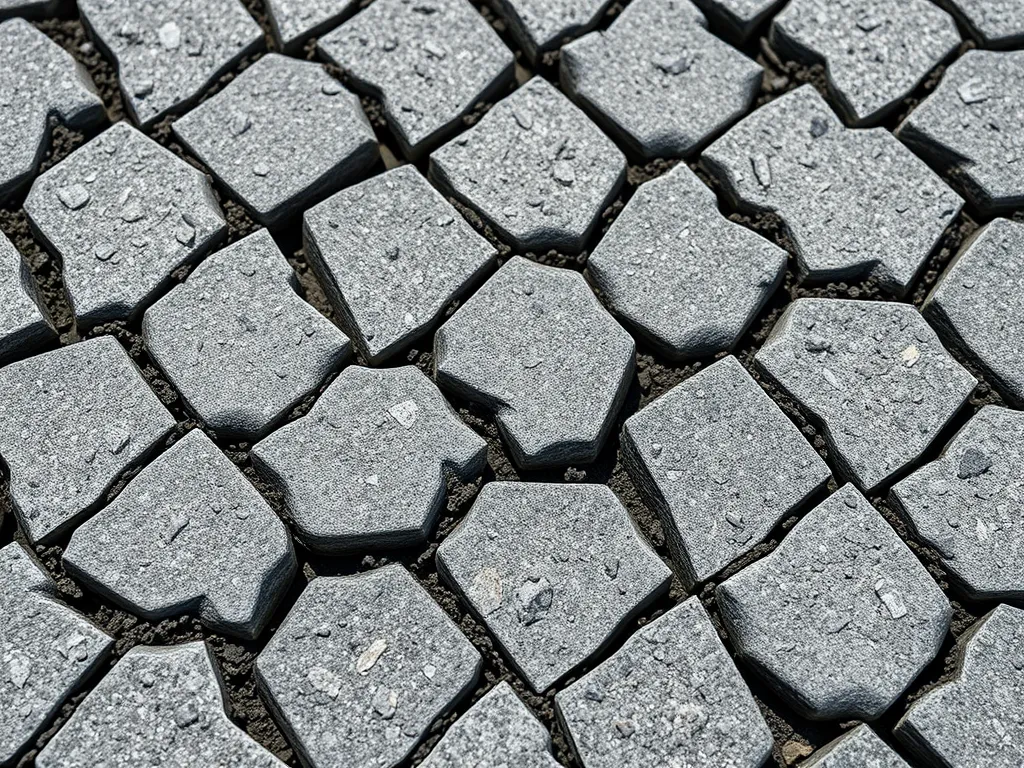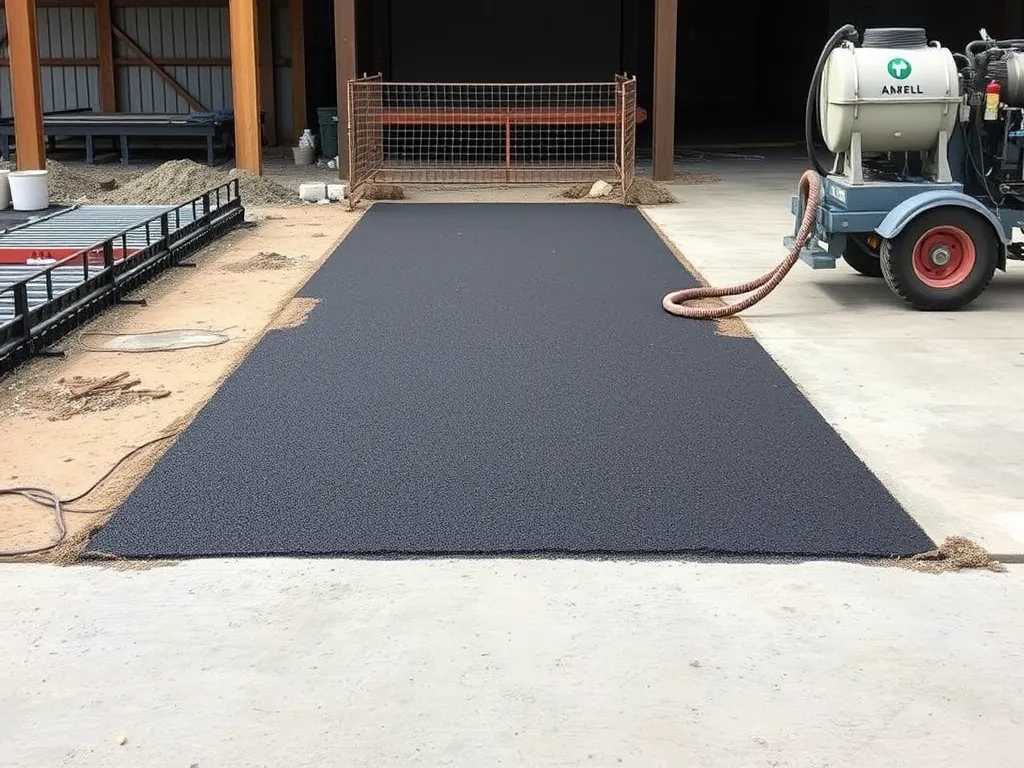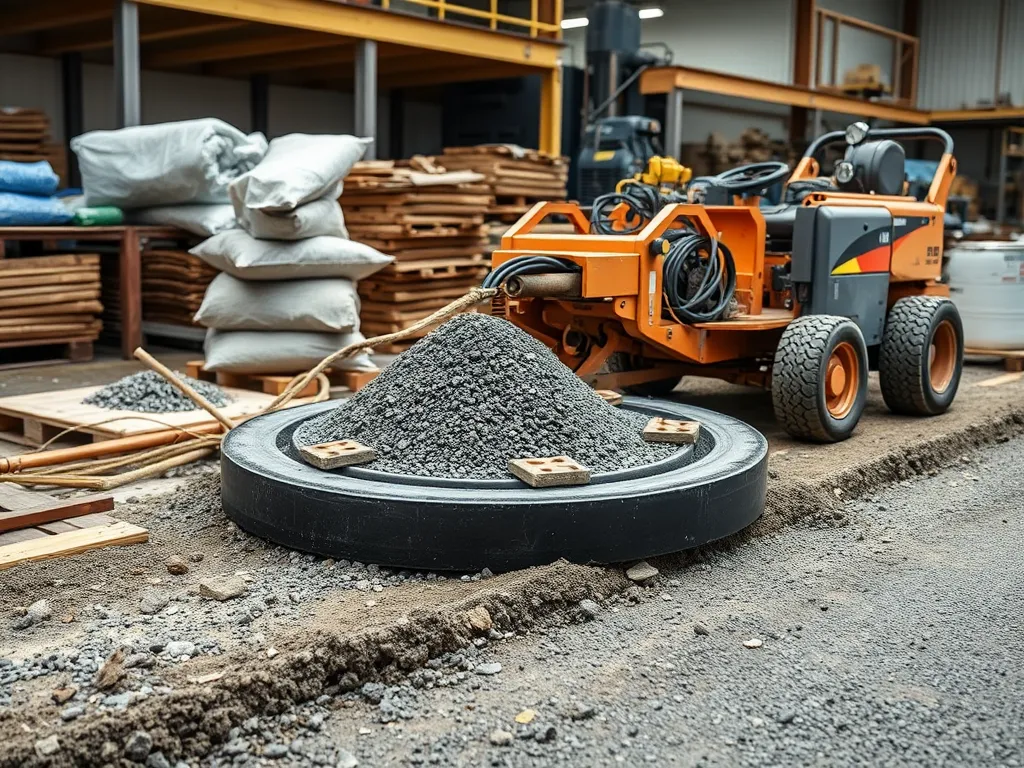Components Of an Asphalt Driveway Base: Essential Layers & Materials
Published on: November 1, 2025 | Last Updated: April 14, 2025
Written By: George Voss
A driveway base is the hidden support system under asphalt pavement, made of five layers: compacted soil (subgrade), crushed stone subbase (6-8 inches thick), aggregate base (4-6 inches), drainage features, and hot mix asphalt. These layers work together to distribute weight from vehicles, stop water pooling, and keep the surface smooth. Materials like angular crushed limestone or recycled asphalt millings are chosen for their load-bearing strength, while slope grading (2% minimum slope) and perforated pipes manage rainwater runoff.
This article explains how each layer functions, why gravel size matters (1.5-inch angular stones lock better than rounded pebbles), and how to avoid common errors like under-compaction. You’ll get cost comparisons ($12-$18 per ton for crushed stone vs $10-$15 for recycled asphalt), equipment tips (use plate compactors for small areas), and thickness guidelines for DIY or pro installations. We’ll also show how to spot base failures like potholes or sinkholes and repair them before asphalt cracks.
Contents
- Core Components Of an Asphalt Driveway Base
- Best Materials for an Asphalt Driveway Base
- Proper Foundation Requirements for Asphalt Driveways
- Step-by-step Asphalt Driveway Base Installation
- Maintaining Your Driveway Base for Asphalt Longevity
- Environmental Considerations
- FAQs: Asphalt Driveway Base Essentials
- Closing Thoughts
- Useful References for You:
Core Components Of an Asphalt Driveway Base
A robust asphalt driveway relies on a carefully engineered foundation. Each layer serves specific functions that combine to create lasting pavement performance. Let’s break down the critical elements from the ground up.
Subgrade Preparation
The natural soil beneath your driveway forms the starting point. Proper prep work here prevents future sinking or cracking.
Soil Stabilization for Load Support
Weak soils require treatment before construction begins. Contractors often mix lime or cement into clay-heavy soils to boost load-bearing capacity. Geotextile fabrics may be added for extra reinforcement. Lab tests determine soil stability using ASTM D698 standards.
Compaction Requirements for Asphalt Stability
Heavy rollers compact the subgrade to 95% Proctor density. This creates a firm platform that resists shifting. Loose soil leads to base layer failure – one reason driveways develop potholes.
Subbase Layer
This coarse layer bridges the subgrade and base, distributing vehicle weight across a wider area.
Crushed Stone or Recycled Asphalt Subbase
#2 crushed stone (1″-3″ angular rock) remains the go-to for drainage and stability. Recycled asphalt millings offer eco-friendly alternatives with 90-95% compaction rates. Both options meet AASHTO M147 standards.
Gravel Subbase Thickness for Driveways (6-8 inches)
Residential driveways need 6-8″ of compacted gravel subbase. Heavy trucks or poor soil conditions may require 12″. Angular gravel locks better than rounded pebbles, reducing lateral movement.
Base Layer
The final stone layer provides a smooth surface for asphalt placement while enhancing structural strength.
Dense-Graded Aggregate Base (DGA) Materials
DGA mixes crushed stone, sand, and fines that compact into a solid mass. Typical specs call for 1″-2″ stones with 8-12% fines passing the #200 sieve. This creates 150-200 PSI load capacity.
Driveway Base Depth Recommendations (4-6 inches)
Most codes mandate 4-6″ compacted DGA bases. Use 6″ for regions with freeze-thaw cycles. Properly installed bases achieve 98% Proctor density – check with nuclear density gauges.
Drainage System
Water management protects both base layers and asphalt surfaces from premature failure.
Slope Grading for Water Runoff
Grade the base with 2% slope (1/4″ per foot) toward edges or drains. This prevents pooling that softens subgrades. Laser-guided equipment ensures precise grading.
Perforated Pipe or Edge Drains (Optional)
French drains with 4″ perforated PVC pipes handle heavy rainfall. Install these 12″ below the subbase in problem areas. Edge drains work well for driveways near retaining walls.
Asphalt Surface Layer
The visible layer depends entirely on the quality of underlying components.
Hot Mix Asphalt Installation Over Compacted Base
Contractors apply 2-3″ of HMA (Hot Mix Asphalt) at 300°F over the prepared base. Properly compacted bases allow steam release during rolling, creating denser pavement. Use PG 64-22 binder for most climates.
With these components properly installed, your driveway gains the structural backbone needed for decades of service. Next, let’s compare specific driveway base materials to match your project needs.
Best Materials for an Asphalt Driveway Base
A strong base determines how well your asphalt driveway handles cars, trucks, and weather. Two materials dominate the market: crushed stone and recycled asphalt. Each offers distinct advantages for driveway base construction.
Crushed Stone Vs. Recycled Asphalt Base
Crushed stone (DGA or dense-graded aggregate) consists of angular rocks ranging from 1.5 inches to fine dust. This interlocking structure creates a stable platform. Recycled asphalt base (RAP) contains milled asphalt pavement mixed with fresh binder. RAP costs 30-40% less than new stone but requires proper compaction.
Load-Bearing Capacity Comparison
| Material | PSI Rating | Cost Per Ton | Best For |
|---|---|---|---|
| Crushed Stone | 250-300 | $18-$25 | Heavy vehicles, high-traffic areas |
| Recycled Asphalt | 200-250 | $12-$18 | Residential driveways, budget projects |
Crushed stone outperforms RAP in sheer strength due to its mineral composition. However, RAP’s bitumen content provides moisture resistance – a key factor in freeze-thaw regions.
Gravel Specifications for Asphalt Support
Not all gravel works for driveway subbase layers. Ideal mixes use 3/4-inch crushed stone with 10-15% fines (stone dust). This blend achieves 95% compaction when properly graded. Avoid pea gravel or river rock – their smooth surfaces reduce stability.
Angular vs. Rounded Aggregate Choices
Angular gravel locks together like puzzle pieces, creating shear strength up to 20% higher than rounded stones. Rounded aggregates shift under pressure, leading to ruts in asphalt surfaces. For optimal performance, choose materials meeting AASHTO M147 standards (common in DOT projects).
With base materials selected, the next step involves preparing the site to exact engineering specs. Proper grading and compaction turn raw materials into a foundation that lasts decades.

Proper Foundation Requirements for Asphalt Driveways
A strong base keeps asphalt driveways crack-free for 15-20 years. Poor prep leads to dips, cracks, and costly fixes. Follow these steps to build right.
Site Preparation Steps
Clear the site of roots, rocks, and debris. Level the ground to remove high spots or holes. Check for soft soil – replace weak zones with crushed stone to prevent sink zones.
Excavation Depth for Multi-Layer Systems
Dig 12-18 inches deep for all layers: 6-8 inches for gravel subbase, 4-6 inches for base, 2-3 inches for asphalt. Add 2 extra inches in frost zones. Use laser levels to check grade slope (2% min).
Compaction Standards
Each layer must hit 95% proctor density (lab test). Loose layers shift under 3,000-lb car weights. Rent gear like plate compactors ($75/day) or rollers ($200/day).
Optimal Moisture Content for Base Materials
Crushed stone needs 8-12% water for tight bonds. Too dry? Dust forms gaps. Too wet? Mud weakens load strength. Test with a squeeze: if it holds shape but crumbles when poked, it’s ready.
Plate Compactor vs. Roller Equipment
- Plate compactor: Best for small driveways (1,000 sq ft). Delivers 5,000 lbs of force. Handles gravel up to 1.5” size.
- Roller: Needs 10-ton models for base layers. Covers large areas fast. Use on recycled asphalt base to seal gaps.
Proper tools and tests set the stage. Next, we’ll break down how to place each layer with zero errors.
Also See: Challenges in Warm Mix Asphalt Application
Step-by-step Asphalt Driveway Base Installation
Build a strong base for your asphalt drive in four key steps. Each layer works to spread weight, block water harm, and stop cracks.
1. Subgrade Inspection & Leveling
Start with the soil layer under your drive. Remove roots, rocks, or soft spots. Test soil strength with a plate compactor – if it sinks 1 inch under 300 psi, add lime or cement mix. Shape the subgrade with a 2% slope (1/4 inch per foot) for drainage.
2. Subbase Installation Process
Spread crushed stone or recycled asphalt millings 6-8 inches deep. Use #57 stone (1-1.5 inch rocks) for best water flow. Compact in 2-inch lifts with a 10-ton roller to 95% density. Check gaps between stones – proper subbase lets water pass but locks in place.
| Subbase Type | Cost per Ton | Load Support |
|---|---|---|
| Crushed Stone | $18-$25 | 12,000 psi |
| Recycled Asphalt | $10-$15 | 8,500 psi |
3. Base Layer Spreading & Compaction
Add dense-graded aggregate (DGA) over the subbase. This 4-6 inch layer uses smaller stones (3/4 inch) mixed with stone dust. Wet lightly before compacting – ideal moisture is 5-8% by weight. Roll until no wheel marks show, hitting 98% compaction for heavy trucks.
4. Final Grading Before Asphalt Pour
Shape the top base layer to match your asphalt thickness. Use a 12-foot screed board to check for dips – fill gaps over 1/4 inch. Confirm the 2% slope remains. Spray a tack coat (asphalt emulsion) at 0.05 gal/sq yd to bind base to new asphalt.
With your base set, focus shifts to surface care. Learn how upkeep stops cracks and extends drive life.

Maintaining Your Driveway Base for Asphalt Longevity
A stable driveway base prevents asphalt cracking and extends pavement life up to 15-20 years. Regular inspections catch issues early before they escalate into costly repairs.
Identifying Base Settlement Issues
Look for sunken areas, diagonal cracks (alligator cracks), or pooling water – these signal compromised driveway base materials. Settlement often stems from inadequate gravel subbase compaction (below 95% Proctor density) or organic soil decomposition under the base. Use a 4-foot straightedge: gaps exceeding ¼ inch over 10 feet confirm uneven support.
Repairing Eroded Subbase Areas
For localized failures, excavate 6-12 inches beyond damaged edges. Replace unstable gravel under asphalt driveway with angular crushed stone (1.5” minus) or recycled asphalt millings. Compact layers in 2” lifts using plate compactors (3,000-5,000 lbf models). Severe erosion may require full-depth reconstruction of driveway base layers – costs average $15-$25 per square foot including materials and labor.
Proactive maintenance preserves your base for asphalt driveway integrity. Next, explore eco-friendly methods like permeable subbase systems that enhance drainage while meeting load requirements.
Environmental Considerations
Driveway base materials impact both structural performance and ecological systems. Modern installations now balance load capacity with stormwater management and material reuse.
Permeable Base Options for Stormwater Management
Open-graded aggregates like 1.5″ crushed stone or 3/4″ recycled concrete create void spaces (35-40% air pockets) for water infiltration. These permeable bases reduce runoff by 50-70% compared to dense-graded materials. For optimal drainage:
| Material | Perc Rate | Cost/Ton |
|---|---|---|
| Crushed Concrete | 12 in/hr | $18-$22 |
| Open-Graded Gravel | 8 in/hr | $25-$30 |
Slope gradients below 2% work best with permeable bases to prevent erosion. Pair with geotextile fabric under the subbase to filter sediments.
Using Recycled Asphalt Millings in Base Layers
Reclaimed asphalt pavement (RAP) millings provide 95% compaction at 6-inch lifts – matching virgin gravel’s structural value. EPA data shows 90 million tons of RAP reused annually in U.S. base courses. Key specs:
- Binder Reactivation: 3-5% new asphalt emulsion added during compaction
- Cost Savings: $8-$12/ton vs. new crushed stone
- Density: 135-140 lbs/ft³ after compaction (meets ASTM D692)
Limit RAP to middle/base layers – avoid direct contact with subgrade soils. Test for contaminants if sourcing from unknown demolition sites.
Proper material selection sets the stage for addressing common installation challenges – let’s examine frequent questions about driveway base layers.

FAQs: Asphalt Driveway Base Essentials
What Materials Go Under an Asphalt Driveway?
The materials that go under an asphalt driveway typically include a strong subgrade made of compacted soil, a subbase layer consisting of crushed stone or recycled asphalt, a base layer of dense-graded aggregate, and a drainage system to manage water runoff. Each of these layers plays a critical role in the structural integrity of the driveway.
How Thick Should Gravel Be Under Asphalt?
For residential driveways, the gravel subbase should generally be 6 to 8 inches thick. In areas with heavy traffic or poor soil conditions, increasing the thickness to 12 inches may be necessary to ensure proper support and durability.
Can You Use Old Concrete As Driveway Subbase?
Yes, old concrete can be used as a subbase for an asphalt driveway if it is crushed into aggregate-sized pieces. This can provide a stable base; however, it is essential to ensure that it is well-compacted and that the pieces are not too large to affect the asphalt layer’s smoothness.
Why Does My Asphalt Driveway Sink in Certain Areas?
Sinking in an asphalt driveway can be caused by various factors, including inadequate compaction of the subgrade or subbase, moisture issues, or the settling of the soil beneath. Identifying the cause early can prevent more significant problems, such as cracks or potholes.
What is the Purpose Of a Drainage System in a Driveway Base?
A drainage system is crucial in a driveway base to manage water runoff effectively. It prevents water from pooling on the surface, which can lead to softening of the subgrade and erosion of the base materials. Proper drainage extends the driveway’s life and maintains its structural integrity.
How Can I Maintain My Driveway Base?
Regular maintenance of the driveway base includes inspecting for signs of settlement, erosion, or pooling water. Prompt repairs of any damaged or eroded areas, keeping drainage systems clear of debris, and ensuring the base remains well-compacted can help prolong the life of your driveway.
Can I Install a Driveway Base Myself?
While it is possible to install a driveway base yourself, it requires careful planning, knowledge of proper materials, and access to heavy equipment for compaction. Hiring a professional can often ensure that the installation meets local codes and specifications for longevity and performance.
What Are the Signs Of a Failing Driveway Base?
Signs of a failing driveway base may include visible cracking in the asphalt, sunken or uneven areas, pooling water, and frequent potholes. Regular inspections and maintenance can help identify these issues early, allowing for repairs before they worsen.
How Does Weather Affect Driveway Base Installation?
Weather can significantly affect driveway base installation. It is best to avoid installing the base in extreme temperatures or during heavy rain, as moisture content can impact the compaction and stability of the materials. Ideal conditions are dry weather with moderate temperatures for optimal results.
Closing Thoughts
Building a solid driveway base is crucial for durability and performance. Each layer, from the subgrade to the top surface, plays a vital role in supporting and distributing weight. Proper materials and installation techniques, such as compaction standards and drainage, contribute to a long-lasting asphalt driveway.
With components like subbase layers made of crushed stone, gravel, or recycled asphalt, you set the foundation for a reliable surface. Always ensure proper grading for effective drainage to extend the life of your driveway. Regular maintenance will help avoid issues like settlement and erosion, preserving your investment.
For more detailed information on asphalt driveway bases and other related topics, visit Asphalt Calculator USA.


